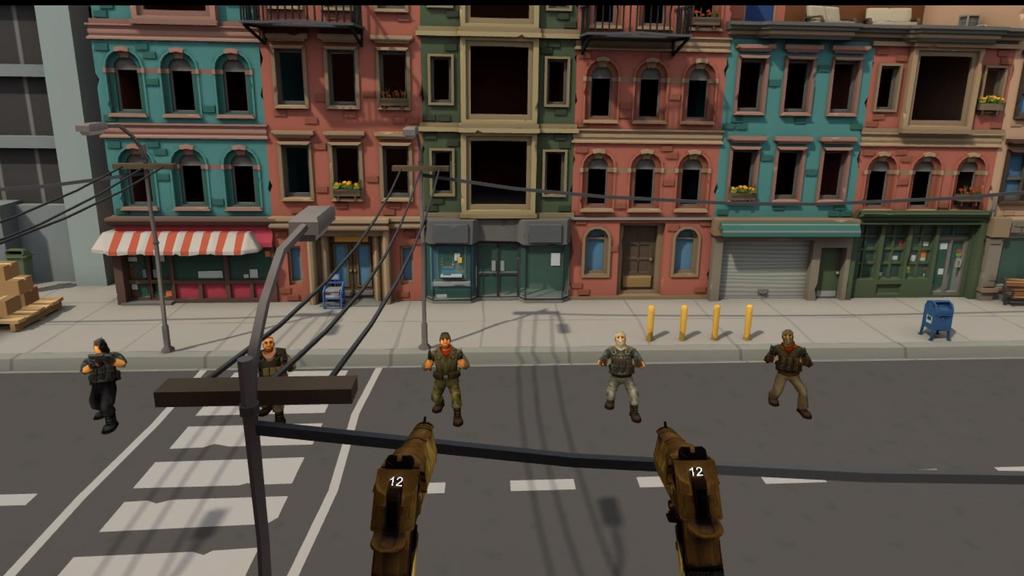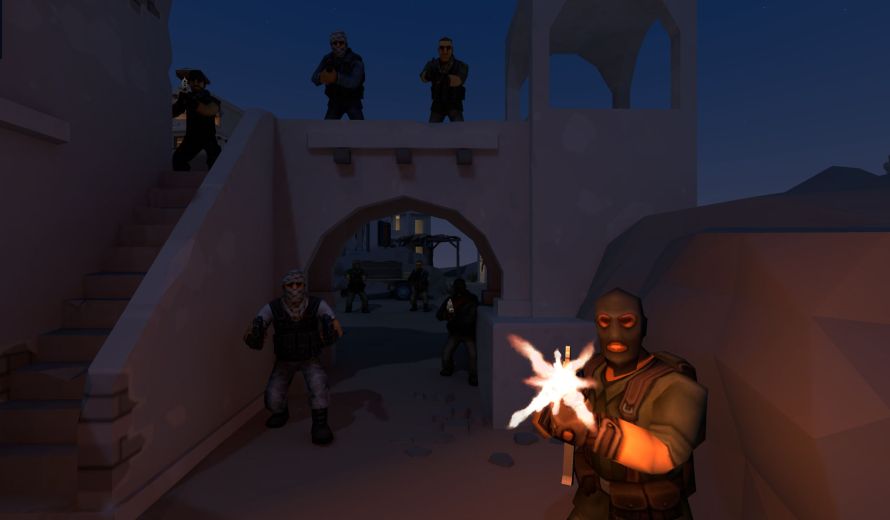Operation Serpens Review
Operation Serpens was first released on PCVR by developer GINRA-TECH back in September 2020. Billed as an arcade shooter, this is a fast-paced game. The developers initially released the game as a fixed location wave shooter but have since updated it to include movement within its stages.
You play as a member of an elite armed force assigned to take out the leaders of the evil terrorist Snakes Organization. The game starts with a forced tutorial that familiarizes the player with the weapon controls. From there, you move onto the first level to capture the first Snake leader. After a quick briefing from your Commander, it’s up to you to neutralize all the enemies to allow the leader’s capture.
The first stage takes place on the third or fourth floor of an office building overlooking a city street with a similar building across the way. There is a mix of civilians and henchmen at the ground level. Henchmen also pop up in the windows of the building.
Upon being offered a sniper rifle to clear out the henchmen, you quickly realize the limitations of the arcade controls. The wild gun spray of automatic weapons and the too-close magnification of the sniper rifle scope make those guns frustrating to use. It also means not hitting pedestrians is a near impossibility. I found the best results with the handguns. While still difficult to aim, I minimized collateral damage.
Moving Around
In VR shooters, players prefer the gunplay to be as realistic as possible. This includes mimicking reloading actions through hand motions. However, such motions take time and are out of place in a frantically paced arcade shooter. So a button press or lowering the weapon to your waist does the reload action.
Despite the update to include locomotion in Operations Serpens, it is quite apparent that the level design did not account for player movement. Most levels are quite small, so the payoff for mobility is quite limited. In the first stage, you can move between the two windows. In other, even smaller stages, you are in an elevator, the back of a truck, or outside a doorway. The major benefit is being able to dodge incoming fire.

Even in these larger areas, including locomotion, the limitations of the level design are made clear. There are geometry issues and clipping happens frequently, hobbling movement. You have to take constant corrective actions to overcome them. This proves to be problematic in the later stages, where you have to do a lot of climbing. Not quite The Call of the Mountain level of climbing, but a lot. Expect to fall through the environment geometry and take hits from enemy weapons fire through said geometry too.
Beyond the standard weapons, there are also grenades, flashbangs, and, a surprise inclusion, a drone. They all work pretty well except for the drone. With the grenades and flashbangs, you can manually pull the pin or use a button input. In addition, you can store them in your mouth, which may surprise you with how often or useful it is to do so. Sadly, the developers missed a great immersion opportunity to not let you pull the pins using your teeth.
Max Payne/Matrix Time
Grenades do the expected damage while flashbangs give a great tactical advantage. In sections where you are heavily outnumbered, the flashbang slows down time for ten seconds, evening things out, similar to the bullet time effect in Max Payne or The Matrix.
Let’s talk about the drone. In theory, this seems like a great gameplay addition. In practice, however, the drone is too slow. You control it with a PDA device that has a left and right joystick. The controls are very finicky and, along with the slow speed of the drone, make its use more frustrating than fun.

Rounding out the controls are the displays on your right and left wrists. Your right wrist shows your percentage completion while the left shows your health status. This allows you to determine exactly how far you are into each level as well as decide when it’s time to collect health packs or riot shields.
From a haptics perspective, its use is rudimentary. There is no use of the adaptive triggers when you fire a weapon. Each round fired gives a brief rumble, but it’s the same rumble no matter which weapon you use.
Gameplay Modes
Three gameplay modes are available. You’ve got the main gameplay mode, which is a seven-stage campaign featuring three difficulty settings. You can also play the campaign in zombie mode. The second mode is a shooting gallery for those that fancy leaderboard competitions. You have three lives to kill as many animated dolls as possible in a bar setting. Finally, there is the wave shooter multiplayer mode that supports cross-platform play. In this mode, you and three other players defend a mall against enemies with limited ammo. This is easily the most engaging and interesting section of the whole game.
Graphically, the game harkens back to the arcades of the late 80s and early 90s. The environments are cartoonish, with no textures and dynamic lighting. Character models exhibit the same traits. The style chosen makes sense as the game is aping the arcade look of a bygone era. There is a certain charm to it, but if you want realistic graphics, best look elsewhere. The framerate is solid and smooth with no reprojection.

Gameplay audio is serviceable, but directionality is unimportant as enemies appear from all parts of the screen. The screens are so busy that it is easier to ignore the audio and just visually track enemies. The gun sounds even wash out the soundtrack.
The VR gaming landscape has changed a lot in the last couple of years. When Operations Serpens first came out, it probably made a bigger splash. Nowadays, VR vets expect more from their games, even retro ones like this. Operation Serpens has a certain charm to it and if you are looking for a mindless retro arcade style shooter, this one should fit the bill for you.
***PSVR2 code provided by the publisher for review***
The Good
- Quick fast-paced action
- Cross and multi-play supported
- Has old-school arcade vibe
The Bad
- Gun spray very wild
- Audio clips recycled too often
- Simplistic graphics
